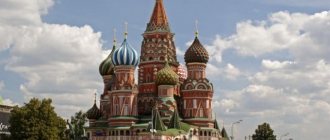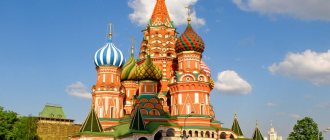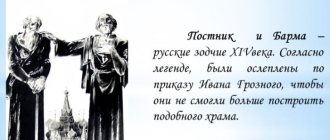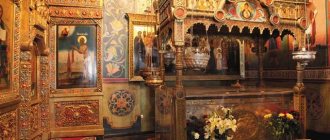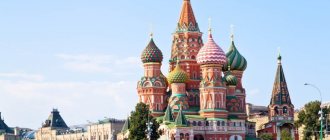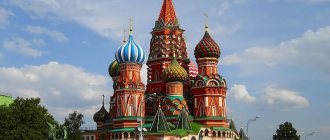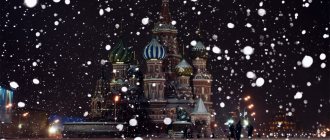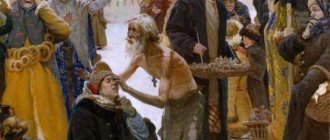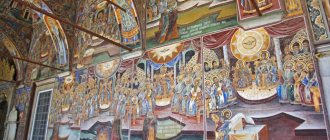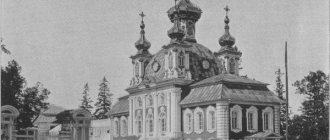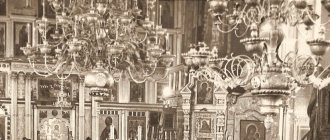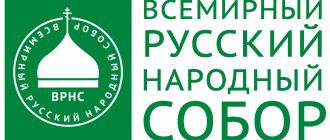Around the Intercession Cathedral
Intercession Cathedral on Red Square.
1.Why was the Intercession Cathedral built on Red Square 2.Who built the Intercession Cathedral on Red Square 3.Postnik and Barma 4.The architecture of the Intercession Cathedral on Red Square 5.Why is the Intercession Cathedral on Red Square called St. Basil's Cathedral 6.St. Basil's Cathedral 7.Cultural layer at the Intercession Cathedral on Red Square 8. Bell tower and bells 9. Additional information about bells and ringing 10. Intercession Cathedral on Red Square. Facade icons 11. Chapters of the Intercession Cathedral
The Cathedral of the Intercession of the Blessed Virgin Mary on the Moat, or, as it is more often called, St. Basil's Cathedral, is a unique monument of ancient Russian architecture. For a long time it has served as a symbol not only of Moscow, but of the entire Russian state. Since 1923, the cathedral has been a branch of the historical museum. It was taken under state protection in 1918, and services there ceased in 1928. However, in the 1990s of the last century, services were resumed and in St. Basil's Church are held every week, in other churches of the cathedral - on patronal holidays. Services are held on Saturdays and Sundays. On Sunday, services are held from 10 a.m. to approximately 1 p.m. On Sundays and religious holidays, excursions to St. Basil's Church are not conducted.
Table of contents
Why was the Intercession Cathedral built on Red Square?
The cathedral was erected in honor of the conquest of the Kazan Khanate. The victory over Kazan was perceived at that time as the final victory over the Golden Horde. Going on the Kazan campaign, Ivan the Terrible made a vow: in case of victory, to build a temple in honor of her. The construction of temples in honor of the most important events and military victories has been a long-standing Russian tradition. At that time, sculptural monuments, columns, and obelisks were unknown in Rus'. However, memorial churches have been erected since ancient times in honor of important state events: the birth of an heir to the throne or a military victory. The victory over Kazan was commemorated by the construction of a memorial church, consecrated in the name of the Intercession. On October 1, 1552, a decisive assault on Kazan began. This event coincided with the celebration of a major church holiday - the Intercession of the Blessed Virgin Mary. The central church of the cathedral was consecrated in the name of the Intercession of the Virgin Mary, which gave the name to the entire cathedral. The first and main dedication of the temple is the votive church. His second dedication was the capture of Kazan.
Who built the Intercession Cathedral on Red Square
The construction of the memorial church was blessed by Metropolitan Macarius. Perhaps he is the author of the idea of the temple, because Tsar Ivan IV the Terrible was still very young at that time. But it is categorically impossible to say this, since very few written sources have reached us.
In Rus', it often happened that, having erected a temple, they wrote down the name of the temple builder (tsar, metropolitan, noble person) in the chronicle, but forgot the names of the builders. For a long time it was believed that the Intercession Cathedral was built by the Italians. But at the end of the 19th century, a chronicle was discovered, from which the true names of the cathedral’s builders became known. The chronicle reads as follows: “The pious Tsar John, having come from the victory of Kazan to the reigning city of Moscow, soon erected a stone church near the Frolovsky Gate above the ditch (Frolovsky - now the Spassky Gate) and then God gave him two Russian craftsmen according to the advertisement (i.e. name) Faster and Barma and superior wisdom and more convenient for such a wonderful work.”
Postnik and Barma
The names of the architects Postnik and Barma appear in sources telling about the cathedral only at the end of the 19th century. The oldest source telling about the Church of the Intercession on the Moat is the Degree Book of the Royal Genealogy, written under the leadership of Metropolitan Athanasius in 1560-63. It talks about the votive construction of the Intercession Cathedral. The Facial Chronicle is no less important. It talks about the foundation of the cathedral, its construction and consecration. The most important, most detailed historical source is the life of Metropolitan Jonah. The Life was created in the 1560-1580s. This is the only source where the names of Postnik and Barma are mentioned. So, the official version today sounds like this: the Church of the Intercession, which was erected on the Moat by the Russian architects Barma and Postnik. According to the unofficial version, this cathedral was built by foreigners of unknown origin. If Italians were previously mentioned, now this version is highly doubted. Without a doubt, when starting the construction of the cathedral, Ivan the Terrible called upon experienced architects. In the 16th century, many foreigners worked in Moscow. Perhaps Barma and Postnik studied with the same Italian masters.
Intercession Cathedral on Red Square. Architecture
The Intercession Cathedral is not one huge church, as it might seem at first glance, but several completely independent churches. It consists of nine temples on a single foundation.
Heads of the Cathedral of the Intercession of the Virgin Mary, which is on the moat
A tent-roofed church rises in the center. In Rus', tented temples are considered to be those that have a pyramidal rather than vaulted ending. Around the central tented church there are eight small churches with large beautiful domes.
It was from this cathedral that the ensemble of Red Square that we are accustomed to now began to take shape. The tops of the Kremlin towers were built in the 17th century; they were built with an eye on the Intercession Cathedral. The tent on the Tsar's tower-gazebo to the left of the Spasskaya Tower repeats the tented porches of the cathedral.
South porch of the Intercession Cathedral with a tent
The Tsar's Tower of the Moscow Kremlin is located opposite the Intercession Cathedral
Eight churches surround the central tented temple. Four churches are large and four are small.
Church of the Holy Trinity - eastern.
Church of Alexander Svirsky – south-eastern.
Church of St. Nikola Velikoretsky - southern..
Church of Varlaam Khutynsky - southwestern.
The Church of the Entry of the Lord into Jerusalem is western.
Church of Gregory of Armenia - northwestern.
The Church of Cyprian and Justina is northern.
St. Basil's Church, behind it is the Church of the Three Patriarchs of Constantinople - northeastern.
Four large churches are oriented to the cardinal points. The northern temple overlooks Red Square, the southern one overlooks the Moscow River, and the western one overlooks the Kremlin. Most of the churches were dedicated to church holidays, the days of celebration of which fell on the most important events of the Kazan campaign. Services in the eight side churches were held only once a year - on the day of the patronal feast. Services were served in the central church from Trinity Day until its patronal feast day - October 1st. Since the Kazan campaign fell in the summer, all church holidays also fell in the summer. All the churches of the Intercession Cathedral were built as summer, cold ones. In winter they were not heated and services were not conducted in them.
Today the cathedral has the same appearance that it had in the 16th-17th centuries. At first, the cathedral was surrounded by an open gallery. Around all eight churches on the second floor there is a belt of windows.
In ancient times, the gallery was open, there were no ceilings above it, and open staircases led upstairs. The ceilings and porches over the stairs were erected later. The cathedral looked and was perceived completely differently than we perceive it today. If now it seems like a huge multi-domed church of incomprehensible design, then in ancient times this feeling did not arise. It was clear that nine soaring churches stood on an elegant, light foundation.
Height at that time was associated with beauty. It was believed that the higher the temple, the more beautiful it is. Height was a symbol of greatness, and in those days the Intercession Cathedral was visible 15 miles from Moscow. Until 1600, when the bell tower of Ivan the Great was built in the Kremlin, the cathedral was the tallest building in the city, and throughout Muscovy. Until the beginning of the 17th century, it served as a town-planning dominant, i.e. the highest point in Moscow. All churches of the cathedral ensemble are united by two bypass galleries: external and internal. The ceilings over the walkway and porches were made in the 17th century, because in our conditions having open galleries and porches turned out to be an unaffordable luxury. In the 19th century, the gallery was glazed. In the same 17th century, a tented bell tower was built on the site of the belfry to the southeast of the temple.
Tent bell tower of the Intercession Cathedral
The outer walls of the cathedral are restored approximately once every 20 years, and the interiors - once every 10 years. Icons are inspected every year, since our climate is harsh and icons are not immune to swelling and other damage to the paint layer.
Why is the Intercession Cathedral on Red Square called St. Basil's Cathedral
Let us remember that the cathedral consists of nine churches on a single foundation. However, ten multi-colored domes rise above the temple, not counting the onion above the bell tower. The tenth green chapter with red spikes is located below the level of the heads of all other churches and crowns the north-eastern corner of the temple.
Head of St. Basil's Church
This church was added to the cathedral after construction was completed. It was erected over the grave of a very famous and revered holy fool of that time, St. Basil the Blessed.
St. Basil the Blessed
This man was a contemporary of Ivan the Terrible, he lived in Moscow, and there were many legends about him. (The miracles of St. Basil are described in the article “The Church of St. Basil.”) From the current point of view, a holy fool is something like a madman, which, in fact, is absolutely wrong. In the Middle Ages in Rus', foolishness was one of the forms of asceticism. St. Basil the Blessed was not a holy fool from birth, he is a holy fool for Christ’s sake, who became one quite consciously. At the age of 16, he decided to devote his life to God. It was possible to serve the Lord in different ways: go to a monastery, become a hermit, but Vasily decided to become a holy fool. Moreover, he chose the feat of the godwalker, i.e. he walked without clothes both in winter and in summer, lived on the street, on the porch, ate alms and spoke incomprehensible speeches. But Vasily was not crazy, and if he wanted to be understood, he spoke intelligibly and people understood him.
Despite such harsh living conditions, St. Basil lived a very long life even by modern times and lived to be 88 years old. He was buried next to the cathedral. Burial near the temple was commonplace. At that time, according to Orthodox tradition, each church had a cemetery. In Rus', holy fools were always revered both during life and after death and were buried closer to the church.
After the death of St. Basil, he was canonized. As if over a saint, a church was erected over his grave in 1588. It so happened that this church turned out to be the only winter one in the entire cathedral, i.e. Only in this temple services were held every day all year round. Therefore, the name of this small church, built almost 30 years later than the Church of the Intercession of the Virgin Mary on the Moat, was transferred to the entire Intercession Cathedral. They began to call it St. Basil's Cathedral.
Cultural layer near the Intercession Cathedral on Red Square
An interesting detail can be seen on the eastern side of the temple. There is a rowan growing there in... a pot.
The tree was planted, as it should be, in the ground, and not in a pot. Over the years, a cultural layer of considerable thickness has formed around the cathedral. The Intercession Cathedral seemed to have “grown into the ground.” In 2005, it was decided to return the temple to its original proportions. To do this, the “extra” soil was removed and taken away. And by that time the mountain ash had already been growing here for decades. In order not to destroy the tree, a wooden cover was made around it.
Bell tower and bells
Since 1990, the cathedral has been jointly used by the state and the Russian Orthodox Church. The building of the Intercession Cathedral belongs to the state, since its funding comes from the state budget.
The church bell tower was built on the site of a dismantled belfry.
The cathedral bell tower is operational. The museum staff make the calls themselves; they were trained by one of the leading bell ringers in Russia, Konovalov. Museum workers themselves provide the accompaniment of church services with bell ringing. A specialist must ring the bells. Museum workers do not trust anyone with the collection of bells of the Intercession Cathedral.
Fragment of the bell tower of the Intercession Cathedral
A person who does not know how to ring, even a fragile woman, can send his tongue incorrectly and break the bell.
More information about bells and ringing
The ancient cathedral belfry was three-tiered, three-spanned and three-hipped. There were bells hanging on every tier in each span. There were several bell ringers and they were all located below. The bell system was ochepnaya or ochepnaya. The bell was firmly attached to the beam and they rang it, swinging not the tongue, but the bell itself.
The bells of the Intercession Cathedral were not tuned to a specific sound; they had only three main tones - one tone at the bottom of the skirt, the second in the middle of the skirt, the third at the top, and there were also dozens of overtones. It is simply impossible to play a melody on Russian bells. Our ringing is rhythmic, not melodic.
To train bell ringers, there were characteristic rhythmic chants. For Moscow: “All monks are thieves, all monks are thieves, and the abbot is a rogue, and the abbot is a rogue.” For Arkhangelsk: “Why cod, why cod, two kopecks and a half, two kopecks and a half.” In Suzdal: “They burned with their shanks, they burned with their shanks.” Each area had its own rhythm.
Until recently, the heaviest bell in Russia was the Rostov bell “Sysoi”, weighing 2000 pounds. In 2000, the “Great Assumption” bell began to ring in the Moscow Kremlin. It has its own history, each sovereign cast his own Greater Uspensky, often pouring over the one that existed before him. A modern one weighs 4,000 pounds.
When the bells ring in the Kremlin, both the bell tower and the belfry ring. The bell ringers are at different levels and cannot hear each other. The chief bell ringer of all Rus' stands on the steps of the Assumption Cathedral and claps his hands. All the bell ringers see him, he beats out the rhythm for them, as if conducting the bells. For foreigners, listening to Russian bells was a martyr's torment. Our ringing was not always rhythmic, often chaotic, the bell ringers had trouble keeping up with the rhythm. Foreigners suffered from this - they were calling everywhere, their heads were pounding from the irregular cacophonous ringing. Foreigners liked the Western ringing more, when they rocked the bell itself.
The bell is a mouth, it has a tongue that speaks in these lips. The bells are divided into “ringing” ones, those on the right hand. This so-called “classic three” weighs half a pound, a pound and one and a half pounds. Bells weighing over one hundred pounds are usually foot or pedal bells. All that is between them is the bells on the left hand, the “keyboard” of the bell ringing. Outsiders are not allowed into the bell towers, because the ringing must go smoothly, but the bells and tongues weigh differently. To equalize them, a system of levers and guy wires is created. All ropes going to the control panel must create the same force. It is then regulated by guy ropes. Therefore, there is always a whole web of different ropes and cables stretched across the bell tower, and an outsider can get entangled, damage the bells and injure himself. Read more about Russian bells in the article “Bells of the Russian Land”.
Intercession Cathedral on Red Square. Facade icons
On the eastern outer wall of the Intercession Cathedral there is a facade icon of the Mother of God. This is the very first facade icon that appeared here in the 17th century. Unfortunately, almost nothing remains of the 17th century letter due to fires and repeated renovations. The icon is called the Intercession with the upcoming Basil and John the Blessed. It is written on the wall of the temple.
The Intercession Cathedral belongs to the Church of the Mother of God. All the local façade icons were painted specifically for this cathedral. The icon, which was located on the south side of the bell tower from the moment it was painted, fell into terrible condition by the end of the 20th century. The south side is most susceptible to the damaging effects of sun, rain, wind and temperature changes. In the 90s, the image was removed for restoration and restored with great difficulty. After restoration work, the icon frame did not fit in its original place. Instead of a frame, they made a protective box and hung the icon in its original place. But due to large temperature changes characteristic of our climate, the icon began to collapse again. After 10 years it had to be restored again. Now the icon is in the Church of the Intercession. And for the south side of the bell tower they wrote a copy right on the wall.
Icon on the bell tower of the Intercession Cathedral
The copy was consecrated when the 450th anniversary of the cathedral was celebrated, on Intercession Day in 2012.
Heads of the Intercession Cathedral
The top of churches, which we call a dome, is actually called a chapter. The dome is the roof of the church. It can be seen from inside the temple. Above the dome vault there is a sheathing on which metal sheathing is fixed.
According to one version, in the old days the domes on the Intercession Cathedral were not bulbous, as they are now, but helmet-shaped. Other researchers argue that there could not be helmet-shaped domes on such thin drums as those of St. Basil's Cathedral. Therefore, based on the architecture of the cathedral, the domes were onion-shaped, although this is not known for certain. But it has been absolutely established that initially the chapters were smooth and monochrome. In the 17th century they were briefly painted in different colors.
The chapters were covered with iron, painted blue or green. Such iron, if there were no fires, could withstand 10 years. Green or blue paints were obtained based on copper oxides. If the heads were covered with German tinned iron, then they could be silver in color. German iron lived for 20 years, but no more.
In the 17th century, the life of Metropolitan Jonah mentions “figured chapters of various types.” However, they were all monochrome. They became variegated in the 19th century, maybe a little earlier, but there is no confirmation of this. Now no one can say why the chapters are multi-colored and different in shape, or on what principle they were painted; this is one of the mysteries of the cathedral.
In the 60s of the twentieth century, during a large-scale restoration, they wanted to return the cathedral to its original appearance and make the chapters monochrome, but Kremlin officials ordered them to be left in color. The cathedral is recognizable primarily by its polychrome domes.
During the war, Red Square was guarded by a continuous field of balloons to protect it from bombing. When anti-aircraft shells exploded, fragments falling down damaged the casing of the domes. The damaged domes were immediately repaired, because if the holes were left, a strong wind could completely “undress” the dome in 20 minutes.
In 1969, the domes were covered with copper. The chapters used 32 tons of copper sheets 1 mm thick. During a recent restoration it was discovered that the chapters were in perfect condition. They just had to be repainted. The central head of the Church of the Intercession has always been gilded.
Each chapter, even the central one, can be entered. A special staircase leads to the central chapter. The side chapters can be entered through external hatches. Between the ceiling and the sheathing there is a space the height of a man, where you can walk freely. The differences in the sizes and colors of the chapters and the principles of their decoration are not yet amenable to historical analysis.
We will continue our acquaintance with the Intercession Cathedral inside the temple, in St. Basil's Church. BASIL'S CHURCH SUB-CHURCH OF THE INTERCLOSURE CATHEDRAL LOWER ENTRANCE OF THE INTERCLOSURE CATHEDRAL ICON OF ST. MAXIMUS THE BLESSED UPPER TIER OF THE INTERCLOSURE CATHEDRAL The article is based on materials from a lecture given by a methodologist of the State Historical Museum in February 2014.
Architectural features of the temple
The building stands out for its appearance among ancient temples. Classic figure eight with domes. Its peculiarity is in the architecture of hipped architecture; it was built one of the last in this style; later they began to build domed buildings.
The tall tent looks like a tall funeral candle. In 1680, a thorough reconstruction was carried out by the new owner of Medvedkovo, and the main iconostasis of the upper church was made. Some of the icons in the temple have been preserved from that period.
The building is 2-storey, the lower floor of the Sign of the Blessed Virgin Mary is heated, the upper floor was cold for a long time, in honor of the Intercession of the Blessed Virgin Mary. There are 5 aisles.
St. Basil the Blessed
Yanina BELOSHAPKINA
Aristarkh LENTULOV VASILY THE BLESSED
1913. State Tretyakov Gallery, Moscow
Multi-colored, bright streams of color, a kaleidoscope of colors... Forms breaking up into separate volumes and sharp edges, twisting into spirals and rushing upward... Magical chaos from which festive domes, elegant zakomars, painted arcades grow - of course, this is the cathedral familiar to us from childhood St. Basil's.
Aristarkh Lentulov is one of the most significant and original participants in the “Jack of Diamonds” and, perhaps, the most daring experimenter. But achieving this identity was not so easy. The formation of Lentulov's style came through the study of cubism, futurism and national traditions.
And so all these disparate and seemingly incompatible elements merged together to present us with the birth of a new original artist. This became clear in 1914, when at the exhibition “Jack of Diamonds” viewers saw two large-scale paintings - “Moscow” and “St. Basil”.
Their appearance was preceded by a whole series of paintings in which the artist worked to create such an abstract form so that at the same time it would not completely lose its outline, balancing on the brink of figurativeness and non-objectivity - a task, at first glance, impossible.
However, as we see, Lentulov manages to accomplish the impossible!
His compositions are made up of a motley collection of cubes, stripes, triangles, but the question “what is this depicted?” does not appear - not only in portraits (which require greater life-likeness), but even in still lifes and landscapes, where a familiar image suddenly appears among colorful spots.
And the variegation and brightness (“color dynamics,” as the artist himself called it) are extraordinary! In some ways, Lentulov can be considered the creator of a new direction in art - “orneism”, although it did not find followers, but he was not very sad about it.
The basis of Orneism is the introduction of foreign materials into the painting, borrowed from the Cubists: gold and silver paper, beads, lace, glass beads... “The material that I used... consisted of colored golden papers, gold leaf and various fabrics - what seemed to me so vividly expresses the essence of the internal way of life, taste and love of Muscovites for decorative, tinsel and lush beauty.
St. Basil is painted in the same way: on a blue background, domes as colorful as parsley alternate with colored papers pasted on with sparkles - something similar to popular prints of Turkish shrines... You can also find a echo with Russian folk pictures...”
Saint Basil in Lentulov’s painting appears (in the best traditions of cubism) to be decomposed into separate forms and facets - it is as if he is being erected before our eyes, like a fairy-tale castle emerging from thin air, creating a feeling of celebration, extravaganza. The cathedral seems to strangely spread out across the plane of the canvas - so that we simultaneously see it from the inside and outside, but there is no feeling of excessive fragmentation of forms; the composition even looks monumental.
Who knows how this direction could develop further. But the First World War offered the artist new themes that distracted him from his previous searches for a long time. Nevertheless, the urban landscape with elements of the architecture of old Moscow remained a favorite theme in Lentulov’s work.
Source: https://art.1sept.ru/article.php?ID=200800212
Sunday School
People come to God at different periods of their lives. Parents bring someone, and the child attends the temple all his life. Many come when they are quite old and want to fully join the faith. This requires new knowledge.
There is a Sunday school at the church. The temple servants invite children and adults to classes. In the lessons, students study theology, the Holy Scriptures of the Old and New Testaments, the catechism, and the history of the Orthodox Church.
Students don’t just come to class like in a public school. They actively participate in the life of the temple. They take part in divine services, sing in the choir, and help priests in organizing Orthodox services.
Worship in the temple
Services are held daily. Matins begins at 8 a.m., all-night vigils at 5 p.m. Parishioners come to the temple on all the great Orthodox holidays and together rejoice at Christmas, Dormition, and Easter. The sacraments are held in the temple: communion, baptism, wedding. Priests perform funeral services for the deceased, and you can order a memorial service.
The service schedule can be viewed on the website. There you can sign up for a tour of the temple. The clergy will talk in detail about the history, architecture and modern existence of the community.
Rare icons
The oldest icons are considered to be the icons of the Most Holy Theotokos and the Old Testament Trinity, which have been in the temple since the end of the 17th century. The festive row is represented by icons of the Nativity of the Blessed Virgin Mary, Epiphany, Resurrection of Christ and Ascension.
The Last Supper icon is located above the royal doors and is made with oil paints, painted in the 18th century. In the chapel of Sergius of Radonezh on the second floor there is an icon of the Cathedral of the Reverend Elders of Optina with particles of relics.
The ancient icon of the Sign, located in the local row of the iconostasis, receives special attention from parishioners. They come to thank Mother and ask for a blessing.
History of the founding of the church
The first mentions of the Taininsky temple occur during the reign of Fyodor Alekseevich and date back to the 17th century. (1628). Then it was a small wooden church, part of the architectural complex of the Travel Palace, which has not survived to this day. Already in 1675, under Alexei Mikhailovich, the construction of a stone temple began. The documents of the State Court preserve detailed descriptions of the overall rich decoration and items of the sacristy.
In 1751, the temple underwent its first reconstruction: by order of Elizabeth Petrovna, a chapel of St. was added to the refectory. Zechariah and Elizabeth. 130 years later, the chapel of the prophet Elijah was built on the other (south) side of the refectory.
The temple has seen both good and bad times. During the War of 1812, the church in Taininsky was mercilessly plundered by Napoleonic troops. And in 1929 it was completely closed by the Soviet authorities. Over the next 70 years, the premises housed a warehouse, a meat shop, a store, and a dormitory. Only in 1989 the temple in Taininsky was reconstructed and opened for worship.
Russian architect or European master
It is still not known for certain who built St. Basil's Cathedral. Researchers have several options. One of them, the cathedral, was built by the ancient Russian architects Postnik Yakovlev and Ivan Barma. According to another version, Yakovlev and Barma were actually one person. The third option says that the author of the cathedral was a foreign architect. After all, the composition of St. Basil's Cathedral has no analogues in ancient Russian architecture, but prototypes of the building can be found in Western European art.
Whoever the architect was, there are sad legends about his future fate. According to them, when Ivan the Terrible saw the temple, he was struck by its beauty and ordered the architect to be blinded so that he would never repeat his majestic construction anywhere. Another legend says that the foreign builder was executed altogether - for the same reason.
The significance of the temple for the culture of Russia
The temple building is a rare monument of tent-roofed architecture in Rus' and is protected by the state. Buildings of this architecture have been severely destroyed over the past centuries. Many cannot be restored, and if they are restored, they get a more modern look.
The Church of the Intercession of the Blessed Virgin Mary is one of the few where it is possible to preserve the centuries-old heritage of antiquity. The ministers try not to change the interior decoration, timely repair and restore both the premises itself and the church utensils.
Churches in Rus' were not only architectural structures, but also the center of life. Priests preach love of God and mercy. In addition, priests lead an active lifestyle and conduct many non-church events, but in accordance with Orthodox canons.
Interior decoration of the Church of the Intercession of the Blessed Virgin Mary.
A beautiful and festive inner temple, quite bright from the windows and faces of saints. Inside the church the iconostasis is classic high. Each row is displayed with icons according to church canons. The iconostasis is crowned with the crucifixion of Christ.
The icons are framed in gilded carved frames. From each wall the face of the Saint looks at the entrance. Believers each come to their own icon, and during the service they turn to the central iconostasis.
Many of the icons are ancient, painted by masters of the 18th century. The work in the temple is being protected and restored. Several icons appeared in the 20th century.
